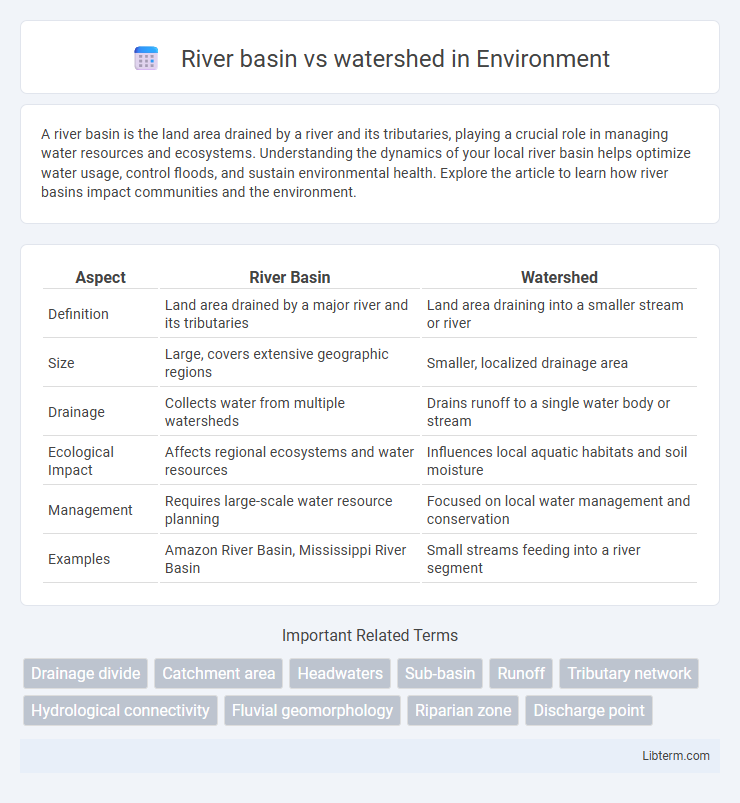A river basin is the land area drained by a river and its tributaries, playing a crucial role in managing water resources and ecosystems. Understanding the dynamics of your local river basin helps optimize water usage, control floods, and sustain environmental health. Explore the article to learn how river basins impact communities and the environment.
Table of Comparison
| Aspect | River Basin | Watershed |
|---|---|---|
| Definition | Land area drained by a major river and its tributaries | Land area draining into a smaller stream or river |
| Size | Large, covers extensive geographic regions | Smaller, localized drainage area |
| Drainage | Collects water from multiple watersheds | Drains runoff to a single water body or stream |
| Ecological Impact | Affects regional ecosystems and water resources | Influences local aquatic habitats and soil moisture |
| Management | Requires large-scale water resource planning | Focused on local water management and conservation |
| Examples | Amazon River Basin, Mississippi River Basin | Small streams feeding into a river segment |
Introduction to River Basins and Watersheds
A river basin encompasses the entire land area drained by a river and its tributaries, forming a hydrological unit essential for water resource management. Watersheds are smaller divisions within river basins, defined by the topographical boundaries that direct rainfall to specific streams or rivers. Understanding the distinction between river basins and watersheds is crucial for environmental planning, flood control, and ecosystem conservation.
Defining River Basin: Key Concepts
A river basin is a large geographic area drained by a major river and its tributaries, encompassing multiple watersheds within its boundary. It collects precipitation and channels surface water through a network of streams, rivers, and lakes toward a common outlet such as an ocean or lake. Understanding the hydrological and ecological dynamics of a river basin is essential for water resource management, environmental conservation, and flood control planning.
Understanding the Watershed: Core Principles
A watershed is a land area that channels rainfall and snowmelt to creeks, streams, and rivers, serving as a fundamental unit for water resource management and ecosystem health. River basins encompass multiple watersheds, collecting surface water that drains into a single river system and flowing towards an outlet such as a sea or lake. Understanding core principles of watersheds involves examining topography, hydrology, land use, and ecological connectivity to manage water quality and prevent flooding effectively.
Geographic Scale: River Basin vs Watershed
A river basin encompasses the entire land area drained by a river and its tributaries, often covering thousands of square kilometers, while a watershed typically refers to a smaller, localized area where all precipitation collects and drains to a single point such as a stream or lake. The geographic scale of a river basin is broader, integrating multiple watersheds within its boundaries, making it a regional or even continental feature in hydrology. Watersheds are crucial for detailed environmental management and hydrological studies at a micro or meso scale, whereas river basins are used for large-scale water resource planning and ecosystem management.
Hydrological Boundaries: Differences and Similarities
River basins and watersheds both define hydrological boundaries that collect and channel precipitation to a common outlet, such as a river or lake. A river basin encompasses a larger land area draining into a major river and its tributaries, while a watershed typically refers to smaller subdivisions within a basin or localized drainage areas. Both entities share the similarity of being natural hydrological units used in water resource management and environmental planning to analyze surface water flow and distribution.
Role in Water Management
River basins and watersheds play critical roles in water management by defining the geographic areas where water collects, flows, and is stored, enabling efficient planning and allocation of water resources. River basins cover larger areas and include multiple watersheds, facilitating integrated management of surface water and groundwater across entire drainage networks to prevent flooding, control pollution, and support agriculture. Effective water management strategies rely on understanding both scales to optimize water distribution, maintain ecosystem health, and ensure sustainable supply for urban, industrial, and ecological needs.
Ecological Importance of River Basins and Watersheds
River basins and watersheds play crucial roles in maintaining biodiversity, regulating water cycles, and supporting aquatic and terrestrial ecosystems. River basins collect precipitation and channel it through interconnected streams and rivers, promoting nutrient cycling and habitat connectivity essential for species survival. Watersheds manage surface runoff and groundwater recharge, reducing soil erosion and filtering pollutants, thereby preserving water quality and ecosystem health.
Human Impact and Land Use
Human impact on river basins often leads to altered water flow, increased pollution, and habitat degradation due to urbanization, agriculture, and industrial activities. Watershed management practices prioritize controlling runoff, reducing erosion, and maintaining water quality by implementing sustainable land use strategies such as afforestation, buffer strips, and controlled development. Effective coordination between river basin authorities and local watershed stakeholders is essential to mitigate the negative effects of land use changes on freshwater ecosystems and downstream communities.
Case Studies: Real-world Examples
The Mississippi River basin spans over 3.2 million square kilometers, illustrating a vast drainage area that feeds into the Gulf of Mexico, impacting multiple states' water resources and flood management policies. Conversely, the Chesapeake Bay watershed, covering about 166,000 square kilometers across six states, demonstrates smaller scale yet intensive land-use impacts on water quality and ecosystem health. These case studies highlight differences in scale and management challenges, emphasizing the importance of tailored conservation strategies for both large river basins and more localized watersheds.
Conclusion: Choosing the Right Term
Choosing between river basin and watershed depends on the scale and context of the hydrological study or management plan. River basins encompass larger areas draining into a main river, making them suitable for regional water resource planning. Watersheds refer to smaller catchment areas feeding tributaries, ideal for local environmental assessments and conservation efforts.
River basin Infographic

 libterm.com
libterm.com